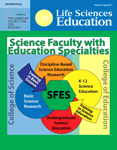A Semester-Long Project for Teaching Basic Techniques in Molecular Biology Such as Restriction Fragment Length Polymorphism Analysis to Undergraduate and Graduate Students
Abstract
Several reports on science education suggest that students at all levels learn better if they are immersed in a project that is long term, yielding results that require analysis and interpretation. I describe a 12-wk laboratory project suitable for upper-level undergraduates and first-year graduate students, in which the students molecularly locate and map a gene from Drosophila melanogaster called dusky and one of dusky's mutant alleles. The mapping strategy uses restriction fragment length polymorphism analysis; hence, students perform most of the basic techniques of molecular biology (DNA isolation, restriction enzyme digestion and mapping, plasmid vector subcloning, agarose and polyacrylamide gel electrophoresis, DNA labeling, and Southern hybridization) toward the single goal of characterizing dusky and the mutant allele dusky73. Students work as individuals, pairs, or in groups of up to four students. Some exercises require multitasking and collaboration between groups. Finally, results from everyone in the class are required for the final analysis. Results of pre- and postquizzes and surveys indicate that student knowledge of appropriate topics and skills increased significantly, students felt more confident in the laboratory, and students found the laboratory project interesting and challenging. Former students report that the lab was useful in their careers.



